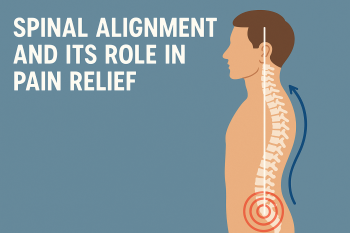
Understanding Vertigo
Vertigo is an extremely challenging and potentially debilitating condition that affects millions of Americans. While some experience intermittent and acute episodes of vertigo, others suffer with chronic spells of vertigo that are frequent and tremendously uncomfortable. Understanding vertigo is similar to understanding headaches; knowing what caused the onset of your vertigo condition is essential for receiving appropriate and effective care along with maximal recovery. Here we will briefly discuss vertigo symptoms, causes, the differences between children and adults, and the chiropractic treatment for vertigo.
Vertigo Symptoms
It is easy to confuse vertigo symptoms with other forms of dizziness. Vertigo symptoms generally include a sensation of “the world spinning uncontrollably.” Often in the midst of a vertigo spell people will lay down on the floor in an attempt to alleviate the feeling of spinning or falling. This sensation is often accompanied by other vertigo symptoms including nausea, vomiting, sweating, and anxiety. These spells can last from seconds to minutes, and in extreme cases can cause loss of consciousness or “blackouts.” Depending on when and how vertigo symptoms come on, some people are at risk for falling and sustaining further injury. It is not uncommon for vertigo symptoms to occur in connection with other conditions such Meniere’s Disease, migraine headaches, concussion/mTBI, and more.
Vertigo Causes
Understanding the underlying cause of vertigo in your case is essential for timely and effective treatment. Vertigo causes are many and varied and can range from serious life-threatening conditions to benign treatable causes. In rare circumstances, more serious conditions such as tumors, infections, or neurological disorders may be the underlying cause of vertigo. For the vast majority of vertigo sufferers, the causes are benign and often treatable with conservative means.
As a disorder of balance and equilibrium, vertigo causes can be traced back to a disharmony between the systems of the body that contribute to keeping your brain and body upright in space and time. The three main systems involved are:
- Oculomotor – the movements of the eyes and their subsequent effect on balance
- Vestibular – the inner ear and it’s mechanisms of balance and coordination
- Proprioceptive – the effect of the joints and muscles of the spine on spatial awareness
Vertigo is commonly caused by a discrepancy in the coordination of these systems. In simple terms, the body, brain, and eyes are working with conflicting information about your spatial awareness. Confusion about which way is up, down, left, or right sends your nervous system into a tailspin, ultimately resulting in the negative symptoms of vertigo.
So what exactly causes this discrepancy? There are many causes, but a very common and treatable cause is called cervicogenic dizziness. Cervicogenic simply means that the problem is coming from the cervical spine. The cervical spine is the neck region, and the upper cervical spine is the top portion of the spine at the junction between the head and the neck. It is in this area where cervicogenic dizziness arises, and conservative and effective treatments are readily available.
Trauma to the head and neck such as whiplash, sports injuries, slips and falls, concussions, and other stresses to the neck can produce a condition known as upper cervical subluxation. Upper cervical subluxation includes two distinct processes:
- abnormal alignment and action of the segments at the top of the spine
- nervous system dysfunction
These two processes compound to produce a variety of side effects by negatively affecting proprioception (spatial awareness). Cervicogenic dizziness and vertigo occur as common side effects of upper cervical subluxation.
What to do About Vertigo
Arriving at an accurate diagnosis of your vertigo condition is essential for appropriate treatment. Conventional treatments usually include pharmaceutical approaches focused on relieving the symptoms associated with vertigo including nausea and vomiting. If your vertigo condition is caused by oculomotor or vestibular dysfunction, there are therapists who are uniquely trained in identifying and treating these conditions using vision therapy or physical therapy. Benign paroxysmal positional vertigo (BPPV) for example responds extremely well to Epley’s Maneuver, a technique focused on treating the crystalline structures within the inner ear.
To focus on the cervicogenic cause of vertigo, you should consult
with a qualified upper cervical chiropractic Doctor if you meet the
following criteria:
- You have a history of head and neck trauma (sports injury, concussion, car accident, etc.)
- You have 2+ spells of vertigo per month
- You experience other side effects of upper cervical subluxation including neck stiffness/pain, pain between the shoulder blades, ringing in the ears, headaches/migraines, poor posture
If you meet these criteria or have explored other options without arriving at definitive answers, you may qualify for upper cervical care. Upper cervical chiropractic care is focused on addressing the underlying cause of cervicogenic vertigo which lies in the condition known as upper cervical subluxation. A qualified upper cervical doctor will help to diagnose your spinal condition, provide a targeted treatment plan, and provide a natural treatment option without twisting, popping, or cracking the spine.
Vertigo in Adults
Vertigo in adults is most commonly associated with migraine headaches, BPPV, or cervicogenic dizziness. It is important to note that there are often multiple conditions with overlapping symptoms involved in adults suffering from vertigo. For example, it is common to have vertigo in combination with migraines and neck pain. These are all conditions that can be traced to a cause of neck dysfunction, and effectively treating the cervical spine can result in alleviation of many or all of these symptoms in certain individuals.
Vertigo in Children
In children, vertigo symptoms are commonly caused by conditions such as ear infections, concussions, or severe fever/infection. It is important to understand the pertinent health history, mechanism of onset, and other key indicators for pediatric patients suffering from vertigo. Cervicogenic dizziness can also affect a pediatric population, and other conditions such as ear infections and poor posture have also been linked to cervical spine dysfunction.
Chiropractic Diagnosis for Vertigo
Chiropractic diagnosis in vertigo cases will be focused on identifying a cervicogenic cause as well as ruling out other life-threatening causes. The process generally starts with a consultation to identify risk factors for upper cervical subluxation, a complete health history, and an understanding of associated signs and symptoms. Diagnostic testing will then be performed to measure structural displacements of the upper cervical spine, nerve system dysfunction, and other key indicators of cervicogenic issues such as postural imbalances, range of motion deficiencies, and balance and coordination issues.
This information serves as the basis for a comprehensive treatment plan focused on correcting the condition underlying cervicogenic vertigo, mainly the upper cervical subluxation. Upper cervical doctors are uniquely trained to perform precision adjustments to the neck without the risks of aggressive manipulation.
Chiropractic Treatment for Vertigo
Patients undergoing chiropractic treatment for vertigo can expect to receive a structured plan of care with clear goals. Upper cervical chiropractors focus on the fix rather than the patch, meaning that care will be focused on correcting the spine rather than alleviating symptoms. This approach allows routine diagnostic testing to guide the process rather than symptomatology which is often inconsistent and unreliable. Upper cervical doctors posit that “holding is healing” which means that not needing to be adjusted is a primary goal of care.
If you or a loved one suffers from vertigo, request a complimentary consultation with a qualified upper cervical doctor to learn if upper cervical care is right for you.







Leave a comment